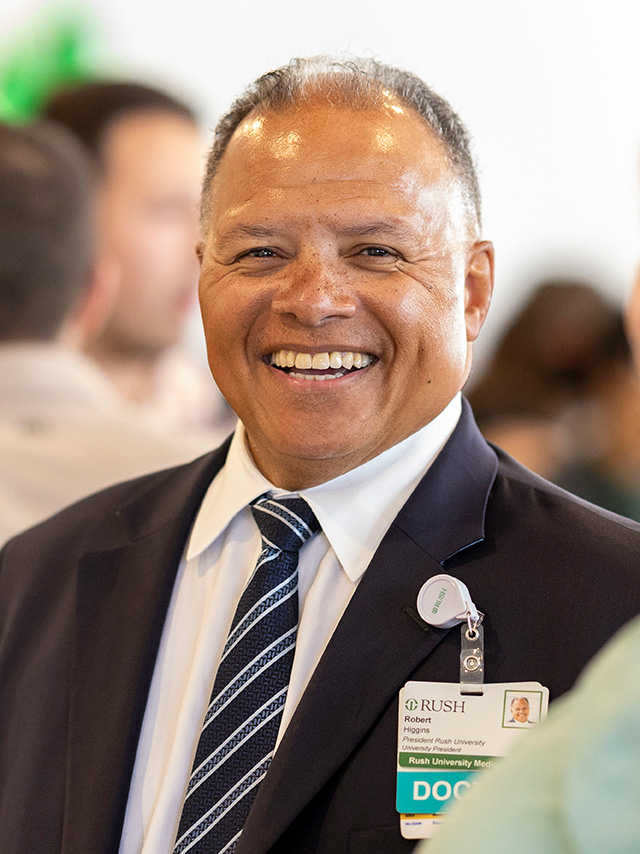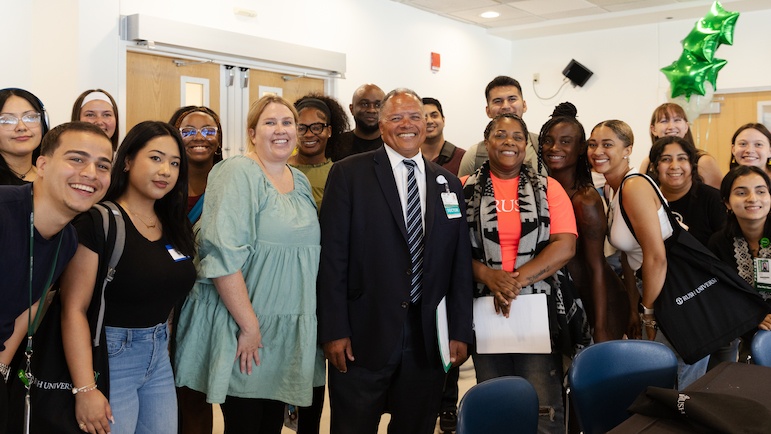As the fifth president of Rush University and chief academic officer and senior vice president of Rush, Robert S.D. Higgins, MD, MSHA, the James A. Campbell, MD, Presidential Chair, is responsible for sustaining and building on Rush University’s strong tradition of academic excellence. This means not only maintaining Rush’s high educational standards and hands-on student experience, but also leading academic and clinical integration at Rush and growing basic, clinical and translational research across the system.
“I’m here to serve the best interests of our students and our faculty, but also the people who work here and everyone we take care of,” he said. “There is something special about Rush, and we can make it something even greater than it is.”
Dr. Higgins feels a responsibility to share the lessons he has learned with others, so all have a chance to thrive. He recently answered questions about Rush’s role in preparing the next generation of health care leaders to create a stronger, more inclusive future and spoke about how philanthropy is vital to this progress.
Did returning to Rush in April 2024 feel like a homecoming, following more than a decade of academic health care leadership with other institutions?
This role holds special significance for me. It’s an opportunity for both my wife, Molly, and I to return to Chicago to be near our three children and, of course, return to Rush. From 2003 to 2010, I served as the Mary and John Bent Professor and Chair of the Department of Cardiovascular-Thoracic Surgery and was also responsible for the Thoracic Surgery Residency Program within Rush Medical College. These years were important in my career, and I remain deeply connected to the values and mission of this extraordinary institution.
What are the defining characteristics of Rush University today?
We are a health sciences university training the next generation of health care providers. That includes physicians, nurses, nurse practitioners, allied health professionals — anybody you would see working in an academic or clinical medical center. We’re trying to do that through a teacher-practitioner model: health care professionals who work at the bedside, teach at the bedside, who do clinical research to improve outcomes for patients.
We do this work with the highest-quality expectations for patient care. If you look at the outcomes for patients who get care at Rush, we’re top in the country by objective standards. It really is outstanding. Rush University serves as a foundational component for the health system.
We have a responsibility to serve the communities in which we reside but also the people we work with to provide outstanding care. The academic setting elevates the responsibility, because we have young people who are learning how to be great physicians, nurses and allied health professionals. Teaching them using the practitioner model is something we’ve done for decades. It remains an important way to empower role models and elevate the student experience. That’s our sweet spot.
Rush University has a long history of innovation, and alumni and friends of Rush are very proud of that. As we evolve, how do you remain true to our history while also helping the university grow and achieve greater success?

We honor the past, but we have to create a sustainable future, and we have to do it now. It’s a new era, and we have new pressures and stresses. We have to evolve, or we won’t be here to discuss our past. We’ll be of historical relevance but not of current impact.
The culture at Rush is a people-centric space. It’s warm, it’s welcoming, it’s appreciative — it’s all those things we value about human relationships. But it’s also technically extraordinary: great patient care, great teaching, loyalty by patients and their families to our past and our present.
We want to honor the tradition when alumni trained here, what they’re so appreciative for, the foundation on which they built their careers. We should laud that. It’s still part of the Rush culture. But we’ve also got new opportunities, and we must be progressive about how we move forward.
What is your vision for the university’s research enterprise?
Rush has been a trailblazer in many ways that we can build upon. We have a tradition of making extraordinary discoveries here. The modern understanding of why people have heart attacks comes from work done at Rush.
We know how to do translational science well — clinical observations which then are used to save people’s lives. The pandemic was a good example. We took on a lot of people who were very, very sick, and we got them through that. We applied the science to save people’s lives. We can take the discoveries that are being made at the basic science institutions around the country and apply them to improve the well-being of our community.
Translational science is really important, and that’s where we’re going to focus on trying to give people resources to apply the science that we know is going to be effective. That’ll be an effort within the medical college and the nursing programs and allied health professions.
What role does philanthropy play in advancing Rush’s mission?
We have to raise funds to invest in ways that our margin might not be able to provide. Philanthropy is critically important; it is the “secret sauce.”
I’ve said nursing is the backbone of health care, but philanthropy is the engine that will help us continue to do this great work, because it generates resources and goodwill, and creates a platform for us to be advocates for this great institution.
Philanthropy can help us expand scholarship and student support programs, which give more of tomorrow’s top talent the chance to get an incredible health care education at Rush, regardless of their socioeconomic status. It allows us to reinvest in faculty and fuels more of the groundbreaking research we do that promotes health equity, improves outcomes and saves lives.
People want to see the medical center grow and develop. By partnering with them, we can make an impact on the future of health care. Nobody does it by themselves. It’s almost a cliché, but I really think it’s true: It’s a team sport.

